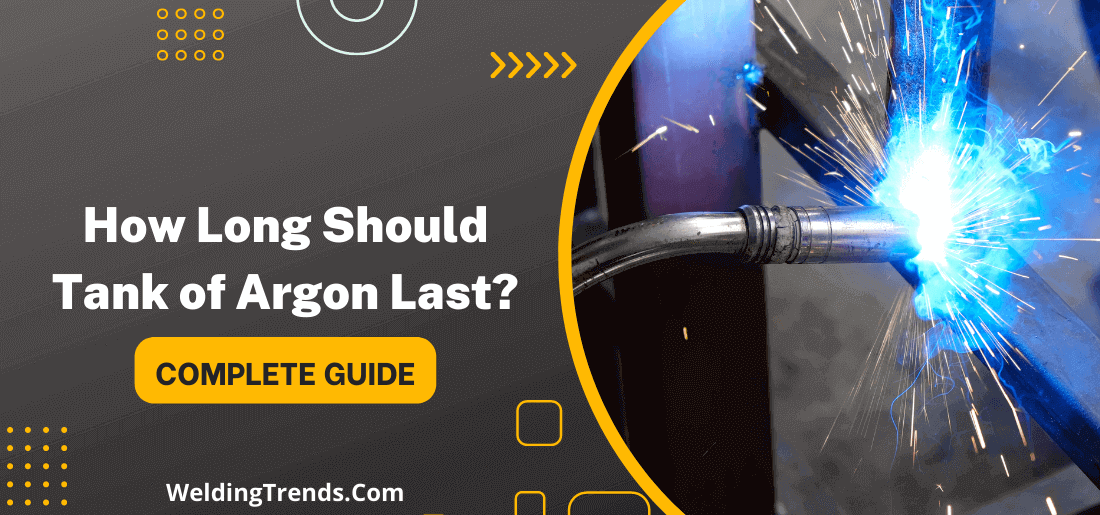This is a question that has come up a few times and there isn’t a definitive answer. When you’re welding with TIG, one of the most important things to consider is the type and size of the tank you’re using.
The amount of time that an argon tank will last for TIG welding depends on the size of the tank, how often it is used and the type of welds being made. In general, a small tank should last for at least 20 hours of TIG welding. Larger tanks may last much longer.
What is TIG welding and what are the benefits of using argon gas?
TIG welding, also known as gas tungsten arc welding (GTAW), is a welding process that uses an electric arc between a non-consumable tungsten electrode and the workpiece to create heat.
This heat creates a molten pool of metal that fuses the two pieces. Argon gas is often used as a shielding gas in TIG welding because it protects the weld from atmospheric contamination.
The main benefits of using argon gas for TIG welding are:
- It helps create cleaner welds by preventing oxidation and other types of contamination.
- Argon is less likely to cause porosity (holes) in the weld than other gasses, such as helium.
- It allows for a more precise weld, which is important in applications where aesthetics or strength are critical.
- Argon is less expensive than some other shielding gasses, making it a cost-effective option for many welding projects.
Overall, argon gas can help improve the quality of TIG welds while also keeping costs down. When used properly, it can help create strong, beautiful welds that will last for years.
How long will a tank of argon last for TIG welding?
This is a difficult question to answer because it depends on a number of factors, including the welding process, the argon gas flow rate and the type of electrode being used.
Generally speaking, a tank of argon gas will last for around 10-12 hours of welding time. However, if you are using a higher flow rate or a different type of electrode, your tank may not last as long.
Assuming you’re using a standard argon tank and welding at 20 amps, you can expect to get approximately 11 hours of welding time out of a single tank.
Of course, this will vary depending on your welding projects and techniques. If you’re welding smaller projects or working with thinner materials, you may be able to extend the life of your argon tank significantly.
In general, however, most welders can expect to get around 10-12 hours of use from a standard argon tank.
What factors can affect how long a tank of argon will last?
Following are the factors that can affect how long a tank of argon will last:
- Size of the tank – Larger tanks will last longer than small ones.
- Flow rate – A higher flow rate will use up the argon gas more quickly.
- Electrode type – Different electrodes may have different gas consumption rates.
- Welding process – Some welding processes use more argon gas than others.
- Material being welded – Thicker materials may require more argon gas than thinner ones.
All of these factors will affect how long a tank of argon gas will last for TIG welding. Be sure to keep them in mind when planning your welding projects.
Tips for prolonging the life of our tank of argon gas
Here are some tips that can help you prolong the life of your argon gas tank:
- Use a lower flow rate. This will help conserve the argon gas and make it last longer.
- Choose a smaller electrode. A smaller electrode will use less argon gas than a larger one.
- Weld thinner materials whenever possible. Thinner materials don’t require as much heat, so you’ll use less argon gas overall.
- Avoid using reactive metals, such as aluminum or magnesium. These metals can consume large amounts of argon gas and cause the tank to run out quickly.
- If possible, use a welding machine with an “argon saver” feature. This will help reduce the amount of argon gas that is used during the welding process.
By following these tips, you can help make your argon gas tank last longer. This will save you money in the long run and help you avoid having to stop in the middle of a project to refill your tank.
Tips for reducing gas consumption when TIG welding with argon gas?
- When TIG welding with argon gas, it is important to keep the torch at a consistent distance from the welding area. This will help to create a more stable arc and prevent the gas from becoming too hot and causing the weld to be less effective.
- It is also important to use a lower power setting when TIG welding with argon gas.
- Another tip for reducing gas consumption when TIG welding with argon gas is to use a shorter welding time. This will assist to decrease the amount of time required for welding the material.
- Finally, it is important to make sure that the argon gas tank is full before beginning to weld. This will help to ensure that there is enough gas to complete the welding process.
By following these tips, it will be possible to reduce gas consumption when TIG welding with argon gas.
FAQs – how long does argon gas last?
When should I fill my argon tank?
It is generally recommended to fill your argon tank when it is half full. This will help to ensure that you always have a sufficient supply of argon on hand and it will also help to reduce the risk of running out of argon entirely.
If you are unsure about when to fill your tank, you can always contact your local gas supplier for more information.
How do I check my argon tank level?
First, locate the tank pressure gauge and unscrew the protective cover. Inside, you will see a needle that indicates the amount of argon gas remaining in the tank. Check that the needle is pointing to the correct level on the gauge and then screw the cover back on.
If you need to refill your argon tank, you can do so at most welding supply stores.
How big of an argon tank do I need?
This depends on a few factors, including how often you plan to use your welder and what type of welding projects you will be working on.
A small argon tank may be sufficient for occasional light welding jobs, while a larger tank may be necessary for more frequent or heavy-duty welding. You can typically purchase argon tanks in a variety of sizes from most welding supply stores.
How do you store argon?
Argon can be stored in a number of ways, depending on the amount that needs to be stored and the application for which it will be used. For small amounts, argon can be stored in cylinders or tanks. Larger quantities may require storage in a cryogenic tank.
When used in welding applications, argon is often stored in cylinders that are connected directly to the welding equipment. This provides a ready supply of argon to the welder and eliminates the need to transfer the gas from one container to another.
Can you use a CO2 tank for argon?
CO2 tanks can be used for argon gas, but it is not recommended. CO2 is a much heavier gas than argon and can cause problems with the regulators and hoses.
In addition, CO2 will react with some metals including aluminum which is often used in welding equipment. For these reasons, it is best to use an argon tank for argon gas.
How long will an 80 cf argon tank last?
Assuming an 80cf argon tank is used at a rate of 20 cfh, it will last approximately 4 hours. If the same tank is used at a lower rate, it will last correspondingly longer.
For example, if the argon tank is used at a rate of 10 cfh, it will last 8 hours. Conversely, if the tank is used at a rate of 40 cfh, it will only last 2 hours.
It should be noted that these are estimates based on ideal conditions. In reality, factors such as temperature and humidity can affect the rate at which argon is used and therefore the duration of time the tank will last.
Last Words
In conclusion, argon gas will last for approximately 12 hours when welding using the TIG process.
Argon tanks should last for multiple TIG welding projects, but it is important to keep track of the amount of time that has passed since the tank was filled. It is also a good idea to have your welder periodically check the argon pressure to ensure quality welds.
Argon tanks can last for a long time if they are maintained properly. Make sure to check the pressure gauge and regulator regularly. If you take care of your argon tank, it will take care of you and provide many years of welding pleasure.




